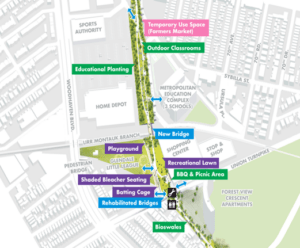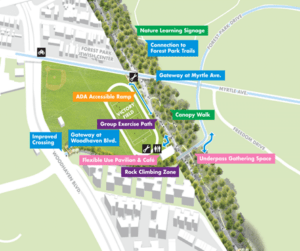Guest contributor Jeremy Espenshade explores a way forward for both a linear park and rail service on the abandoned Rockaway Beach Branch.
This piece was corrected on 5/8/2024 to fix some typos, attributions, and the correct length of the proposed QueensLink rail project.
Inspecting a satellite map of Queens, you may notice two slices of green cutting north to south: one in a graceful arc from Woodside down through Ridgewood and into Brooklyn, the other bending through Rego Park before shooting a straight path through Ozone Park on its 3.5 mile route to Jamaica Bay. The first of these arcs will be the home of the Interborough Express, a $5.5 billion light rail line backed by Governor Kathy Hochul and actively being developed by the MTA. The second is an abandoned section of the Long Island Rail Road Rockaway Beach Branch with its future at a crossroads.
For many years, there have been two competing visions for this corridor:
- The QueensWay envisions transforming the elevated rail bed and surrounding land into a 47 acre linear park.
- The QueensLink envisions 33 acres of new parkland complementing an M line Subway extension from Rego Park to the Rockaways.


QueensWay and QueensLink proposals
The QueensWay vision is currently moving toward realization. The FY2023 NYC budget allocated $35 million for design and construction of a 5 acre park on the Metropolitan Hub section, a 0.7 mile stretch between Metropolitan Avenue and Union Turnpike. This March, Senator Schumer announced federal funding of $117 million for a second phase extending south from Union Turnpike through Forest Park.

Phase 1: Metropolitan Hub Section

Phase 2: Forest Park Pass Section
While strongly supportive of new parkland, QueenLink advocates are rightfully worried that the way these parks are designed will preclude future rail conversion. Queens Community Board meetings about the QueensWay have revolved around the possibility of rail reactivation, with representatives from the Queens Borough President, board members, and advocates all imploring consideration from the NYC Parks and NY EDC representatives. While there are some residents opposed to parks entirely, including one who relayed a colorful but dubious tale of finding sacrificial altars strewn with headless chickens along the trails deep in Forest Park, the primary conflict is between rails and parks versus parks without the possibility of rail.
How did we get here?
The Friends of the QueensWay community group formed in Rego Park in 2011 with the goal of establishing an elevated park, and partnered with The Trust for Public Land to produce the QueensWay Plan in 2014. This plan was funded by NY State Parks and the Governor’s Regional Economic Development Council grants. Travis Terry, the current Friends of the Queensway President, played a key advocacy role through his political consultancy, Capalino. Further funding for designing the Metropolitan Hub section was secured in 2016 with the help of State Assemblyman Andrew Hevesi, City Councilwoman Karen Koslowitz, and several private foundations. Dormant for several years, the proposal gained new life in Mayor Eric Adams administration, who included initial phase funding in his first NYC budget. While not a visible campaign issue, Adams’ administration moved quickly to fund phase 1 development after Capalino assisted with then-candidate Adams’ mayoral campaign and transition, which has motivated allegations of backroom deals between Terry and Adams, who Terry praised at a QueensWay community board meeting in November 2023.
Starting on the other end of the LIRR Rockaway Beach Branch, support has been building for rail reactivation. Queens Community Board 14 in Far Rockaway passed a 2012 resolution in support, the MTA included reactivation of this section of the Rockaway Line as a possibility in their 2013 20 year needs assessment, Assemblyman Goldfeder funded a preliminary use study of rail reactivation by Queens College in 2013, and funding for an MTA feasibility study was included in the 2016 state budget.
Unfortunately, the MTA study reported a shockingly high price tag: $8.1 billion dollars for 3.5 miles of rail. Community groups, including the Queens Public Transit Committee (QPTC), whose president Phil McManus warned, “we are going to have to monitor this study and make sure that it is done correctly,” suspecting the MTA was artificially inflating the estimate. An independent review commissioned by QueensRail, an advocacy group founded by Rick Horan, found that the MTA used non-standard estimation techniques and produced an alternative estimate between $3.4 and $3.7 billion. While the MTA partially revised the cost down in their 2023 20 year needs assessment they also reduced ridership estimates. Amid ongoing concern about the MTA’s estimates, Mitchell Moss, NYU Professor of Urban Planning, noted that, “The reality is that the MTA can only focus on so many projects, and the Second Avenue Subway and Interborough Express have their and the Governor’s attention.”
Regardless of the MTA’s current priorities, the community and political support around rail reactivation has only grown during this time. Initial advocacy for rail reactivation instead of parks pivoted to a “Rails and Trails” vision by QueensLink cofounders Rick Horan and Andrew Lynch. This vision has won the support of NY State Senator Jessica Ramos, NY State Assemblymember Jessica Gonzalez Rohas, City Councilperson and former NYC Parks Commissioner Shekar Krishnan, NYC Public Advocate Jumanne Williams, Queens Borough President Donovan Richards, Transportation Committee Chair Selvena Brooks-Powers, and various other elected officials and community groups many of whom rallied for QueensLink at city hall in September 2023. Recent advocacy for inclusion in this year’s NY State budget generated more than 13 thousand emails and phone calls, and while funding was not included in the final bill, QueensLink organizers have vowed to continue their advocacy.
A Better Way Forward
While often framed in an adversarial manner, the QueensWay and QueensLink visions have many goals and components in common, including expanded park access, a bike lane network supporting cross-borough connectivity, safe pedestrian corridors, and improved quality of life for Queens residents. Without the active support of the MTA or state government, the window of opportunity for taking a transit-first development approach has also effectively closed, leaving a park-first approach as the reality. The first two phases of park development at the Metropolitan Hub and Forest Park Passage sections are funded and progressing through design and community feedback phases. Construction is expected to start within a year.
A park-first approach doesn’t need to preclude eventual transit expansion, however. Better connectivity and transportation will only grow over time, as both Adams and Hochul prioritize efforts that will increase housing density and job centers in Queens. The Rockaway Beach Branch is also the only remaining right of way through the developed part of New York City, and as such represents the last hope of significantly expanding transit access without extensive tunneling. Building the QueensWay parks in such a way as to preclude rail reactivation in the future would therefore be a historically short sighted decision akin to Robert Moses building the Verrazano Bridge and Long Island Expressway without affordance for future mass transit development, which has doomed Staten Island and Long Island residents to traffic snarled commutes and artificially limited the whole region’s growth.
Putting QueensWay on the right track therefore involves building parks, yes, but in the right way: incorporating the possibility of rail reactivation as a guiding principle and nonnegotiable design goal. I implore Mayor Adams, Governor Hochul, and the rest of our elected officials to think of their legacy and instruct NYC Parks and EDC to make this contribution to future generations of New Yorkers.
You can reach the author of this piece, Jeremy Espenshade, at je2478@nyu.edu
You can reach the editor of this piece, Calley Wang, at: csw9856@nyu.edu